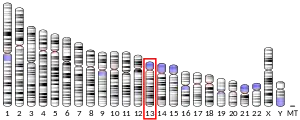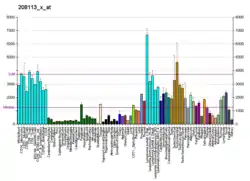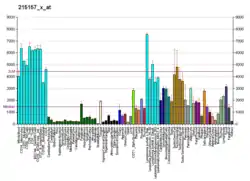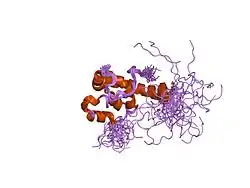PABPC3
Polyadenylate-binding protein 3 is a protein that in humans is encoded by the PABPC3 gene.[3][4][5] PABPC3 is a member of a larger family of poly(A)-binding proteins in the human genome.
| PABPC3 | |||||||||||||||||||||||||
|---|---|---|---|---|---|---|---|---|---|---|---|---|---|---|---|---|---|---|---|---|---|---|---|---|---|
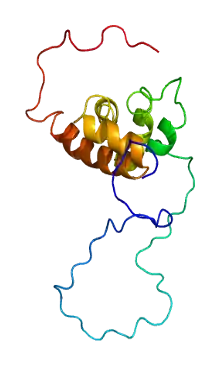 | |||||||||||||||||||||||||
| |||||||||||||||||||||||||
| Identifiers | |||||||||||||||||||||||||
| Aliases | PABPC3, PABP3, PABPL3, tPABP, poly(A) binding protein cytoplasmic 3 | ||||||||||||||||||||||||
| External IDs | OMIM: 604680 HomoloGene: 118007 GeneCards: PABPC3 | ||||||||||||||||||||||||
| |||||||||||||||||||||||||
| |||||||||||||||||||||||||
| |||||||||||||||||||||||||
| Orthologs | |||||||||||||||||||||||||
| Species | Human | Mouse | |||||||||||||||||||||||
| Entrez |
| ||||||||||||||||||||||||
| Ensembl |
| ||||||||||||||||||||||||
| UniProt |
| ||||||||||||||||||||||||
| RefSeq (mRNA) |
| ||||||||||||||||||||||||
| RefSeq (protein) |
| ||||||||||||||||||||||||
| Location (UCSC) | Chr 13: 25.1 – 25.1 Mb | n/a | |||||||||||||||||||||||
| PubMed search | [2] | n/a | |||||||||||||||||||||||
| Wikidata | |||||||||||||||||||||||||
| |||||||||||||||||||||||||
References
- GRCh38: Ensembl release 89: ENSG00000151846 - Ensembl, May 2017
- "Human PubMed Reference:". National Center for Biotechnology Information, U.S. National Library of Medicine.
- Morris CM, Bodger MP (Mar 1993). "Localization of the human poly(A)-binding protein gene (PAB1) to chromosomal regions 3q22-q25, 12q13-q14, and 13q12-q13 by in situ hybridization". Genomics. 15 (1): 209–11. doi:10.1006/geno.1993.1037. PMID 8432538.
- Feral C, Mattei MG, Pawlak A, Guellaen G (Nov 1999). "Chromosomal localization of three human poly(A)-binding protein genes and four related pseudogenes". Hum Genet. 105 (4): 347–53. doi:10.1007/s004390051113. PMC 1865476. PMID 10543404.
- "Entrez Gene: PABPC3 poly(A) binding protein, cytoplasmic 3".
Further reading
- Marques AC, Dupanloup I, Vinckenbosch N, et al. (2006). "Emergence of young human genes after a burst of retroposition in primates". PLoS Biol. 3 (11): e357. doi:10.1371/journal.pbio.0030357. PMC 1251493. PMID 16201836.
- Gerhard DS, Wagner L, Feingold EA, et al. (2004). "The status, quality, and expansion of the NIH full-length cDNA project: the Mammalian Gene Collection (MGC)". Genome Res. 14 (10B): 2121–7. doi:10.1101/gr.2596504. PMC 528928. PMID 15489334.
- Strausberg RL, Feingold EA, Grouse LH, et al. (2003). "Generation and initial analysis of more than 15,000 full-length human and mouse cDNA sequences". Proc. Natl. Acad. Sci. U.S.A. 99 (26): 16899–903. doi:10.1073/pnas.242603899. PMC 139241. PMID 12477932.
- Féral C, Guellaën G, Pawlak A (2002). "Human testis expresses a specific poly(A)-binding protein". Nucleic Acids Res. 29 (9): 1872–83. doi:10.1093/nar/29.9.1872. PMC 37253. PMID 11328870.
- Wiemann S, Weil B, Wellenreuther R, et al. (2001). "Toward a catalog of human genes and proteins: sequencing and analysis of 500 novel complete protein coding human cDNAs". Genome Res. 11 (3): 422–35. doi:10.1101/gr.GR1547R. PMC 311072. PMID 11230166.
- Hoshino S, Imai M, Kobayashi T, et al. (1999). "The eukaryotic polypeptide chain releasing factor (eRF3/GSPT) carrying the translation termination signal to the 3'-Poly(A) tail of mRNA. Direct association of erf3/GSPT with polyadenylate-binding protein". J. Biol. Chem. 274 (24): 16677–80. doi:10.1074/jbc.274.24.16677. PMID 10358005.
External links
- PDBe-KB provides an overview of all the structure information available in the PDB for Human Polyadenylate-binding protein 3 (PABPC3)
This article is issued from Wikipedia. The text is licensed under Creative Commons - Attribution - Sharealike. Additional terms may apply for the media files.
